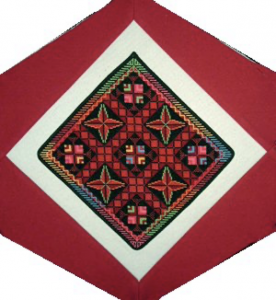Palestine

The Block
Palestinian embroidery, consisting of very small, densely packed cross-stitches, is an important folk-art taught at an early age to young girls and proudly passed on to each generation. Traditionally, each region of the country had its own distinctive colours and patterns (generally geometric) that show the identity of a group. For this piece, however, blockmaker Violet Siekaly Srigley, masterfully incorporated several symbols (the cypress tree or saru, which stands for death and rebirth; the Crusader’s Cross; the Holy Mount of Olives) and motifs (the popular feathered pattern known as Reesh, and candlesticks) to create a design that reflects the whole nation. The piece, framed by a colourful, border-moon pattern, is a wonderful example of the universally recognized embroidery tradition that is so much a part of the Palestinian cultural heritage.
Cultural Profile
Palestine, located in the Middle East, is a region with an extremely diverse terrain. The country was once known as Canaan, “The Land of the Purple,” because its inhabitants decorated linen and woolen cloth with a precious, purple dye extracted from murex sea-snails. Th dyed fabrics produced were prized trade items around the Mediterranean. Industries within the country are generally small family businesses that produce textiles, soap, pottery, renowned Hebron glass, olive-wood carvings and mother-of-pearl souvenirs. Arabic and Hebrew are the primary languages spoken, although English is widely understood.
Textiles made in Palestine include the keffiyehs, the emblematic white scarves featuring a black fishnet pattern worn by many in the country. The scarf has become extremely popular worldwide since the 1990s. However, cheaper mass-produced versions have flooded international markets and this is having adverse effects on local manufacturers. Today, keffiyehs are still made in one factory in Palestine. Majdalawi weaving is also a typically Palestinian art, originating from the town of Majdal. It is woven on single treadle looms using black and indigo cotton threads combined with silk threads in fuchsia and turquoise. Efforts are under way to preserve this technique in Gaza by teaching young people this art. Gaza also used to be a center of silk weaving, where exceptionally fine gazzatum silk cloth was made and exported to Europe. The English word gauze comes from this filmy fabric. Silk is no longer produced in Gaza. Bedouin women also play an essential part in preserving their nomadic culture. They are responsible for weaving the fabric used to make tents, floor coverings and various household items on ground looms that allow for great lengths of fabric to be woven.
Traditionally, Palestinians are known for being very hospitable people. In the days before television and radio, folktales were the principal nightly entertainment; guests were welcome to stay in a madhafah (guest house) and to hear the stories passed down through the generations. Today Palestinian folklore, which covers such cultural aspects as literature, customs, clothes, embroidery and pottery, has become increasingly important as a part of the nation’s identity. Music also plays a key role in Palestinian life and each occasion has its own songs. Palestinians are known for their dance troupes.
Due to the ongoing conflict in Palestine there are more Palestinians living outside of the Gaza Strip and the West Bank territories than inside. Today, there are over 31,000 Canadians of Palestinian ancestry in Canada. Palestinian immigrants came to Canada seeking refuge and better opportunities for their families.
Sponsor: Carol Campbell
